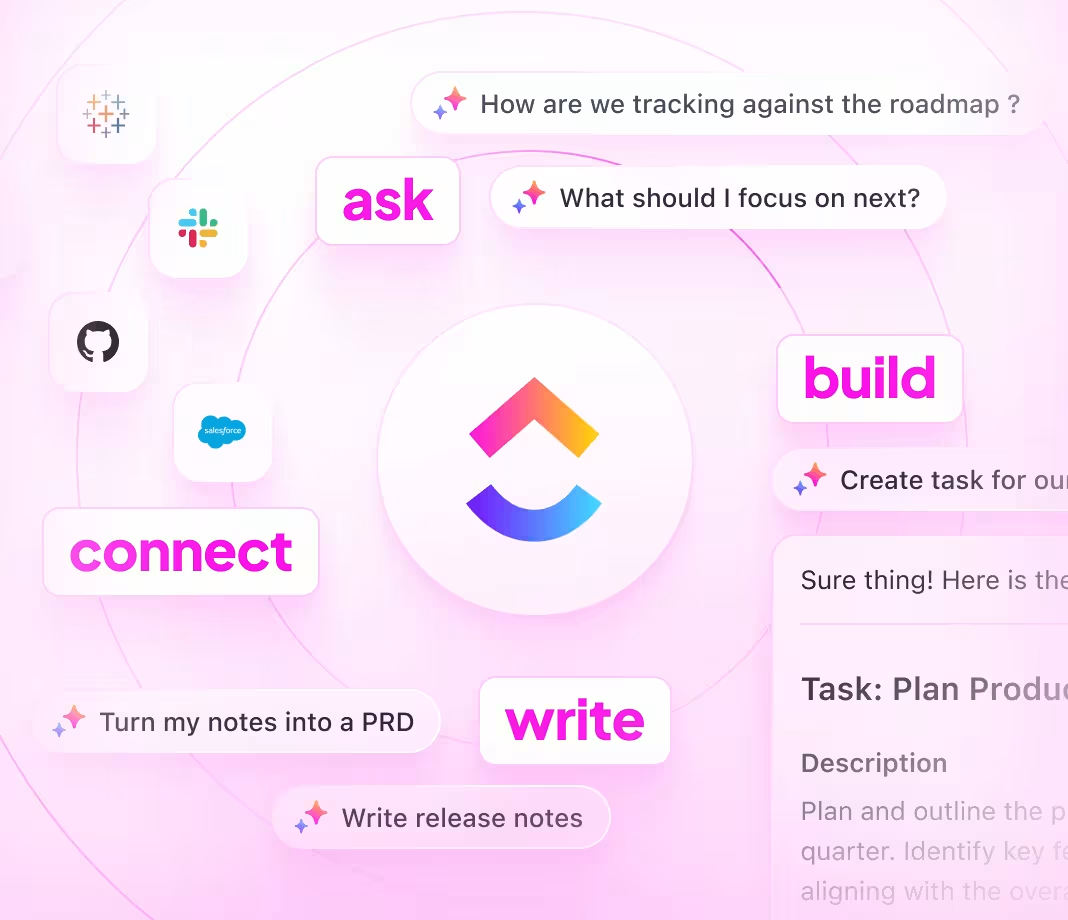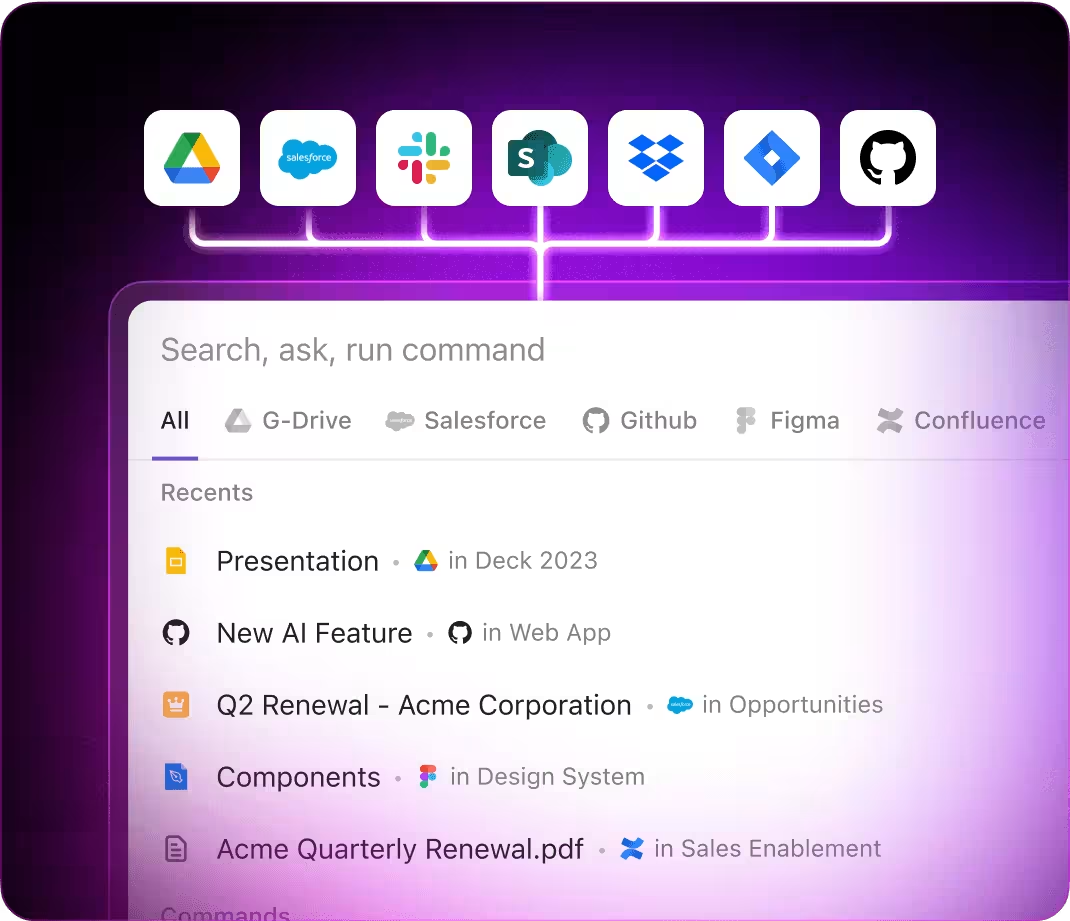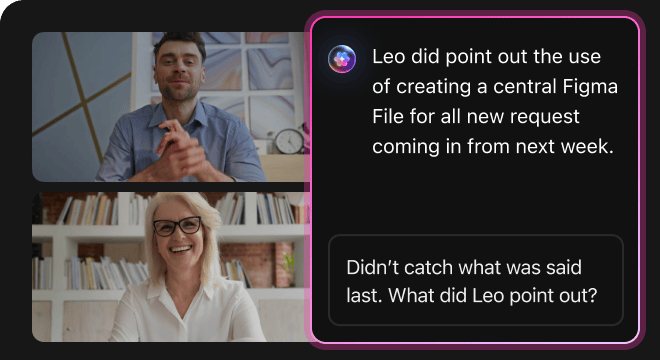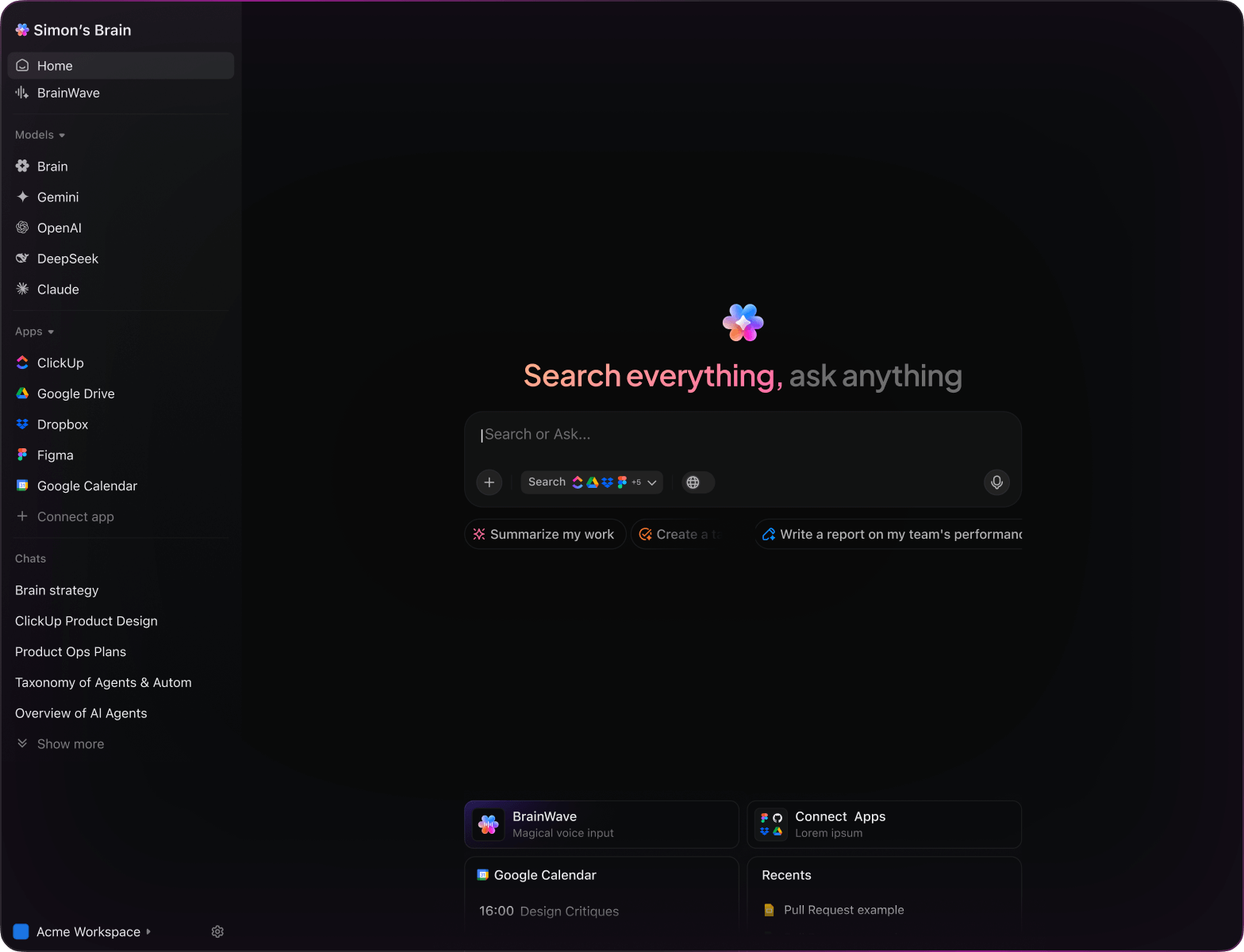AI Javascript Development
Top AI Prompts for Javascript with ClickUp Brain
Accelerate your coding, organize projects effortlessly, and elevate your Javascript solutions using ClickUp Brain's intelligent assistance.

Trusted by the world’s leading businesses
AI in JavaScript Development
How AI Prompts Enhance JavaScript Development Workflows
Building dynamic web applications requires more than just coding—it demands coordination, clarity, and speed.
From initial feature planning to debugging, testing, and deployment, JavaScript projects juggle numerous tasks, files, and collaboration points. AI prompts are now pivotal in managing this complexity.
Developers leverage AI to:
- Quickly identify relevant code snippets and best practices
- Generate boilerplate code, function templates, and documentation effortlessly
- Break down complex logic into understandable summaries
- Transform meeting notes and bug reports into prioritized action items
Integrated within familiar tools—such as code editors, project boards, and documentation platforms—AI in ClickUp Brain doesn’t just assist; it actively organizes your ideas into clear, executable steps.
Comparing ClickUp Brain with Conventional AI
Why ClickUp Brain Stands Apart
ClickUp Brain integrates seamlessly, understands your context, and empowers you to focus on coding, not explaining.
Standard AI Solutions
- Constantly toggling between apps to collect info
- Repeating project details in every query
- Receiving generic, irrelevant suggestions
- Hunting through multiple platforms for one snippet
- Interacting with AI that only processes input
- Manually switching between different AI engines
- Merely a browser add-on without deep integration
ClickUp Brain
- Instantly accesses your JavaScript tasks, docs, and team notes
- Tracks your coding progress and project objectives
- Delivers precise, context-driven guidance
- Searches all your resources in one place
- Supports voice commands with Talk to Text
- Automatically selects the optimal AI model: GPT, Claude, Gemini
- Dedicated Mac & Windows app designed for performance
Prompts for JavaScript Development
15 Essential AI Prompts for JavaScript Projects
Accelerate your JavaScript coding—debugging, optimization, and feature planning simplified.

Outline 5 innovative UI component ideas for a React-based dashboard, inspired by the ‘Q3 UI Concepts’ doc.
ClickUp Brain Behaviour: Analyzes design notes and component descriptions from the linked document to propose fresh UI concepts.

What are the latest best practices for asynchronous data handling in Node.js applications?
ClickUp Brain Behaviour: Gathers insights from internal knowledge bases; Brain Max can supplement with current public resources if accessible.

Draft a coding guideline for writing modular JavaScript functions following ES6 standards, referencing Style Guide v2 and previous code reviews.
ClickUp Brain Behaviour: Extracts relevant coding principles and examples from linked documents to create a structured guideline.

Summarize performance comparisons between React and Vue.js for single-page applications using our ‘Frontend Frameworks Q1’ report.
ClickUp Brain Behaviour: Pulls data and analysis from internal reports and delivers a concise comparative summary.

List top libraries for state management in JavaScript, referencing R&D notes and developer feedback docs.
ClickUp Brain Behaviour: Scans internal documents to identify frequently recommended libraries and their key features.

From the ‘API Integration Testing’ doc, generate a checklist for validating RESTful endpoints.
ClickUp Brain Behaviour: Identifies testing criteria and formats them into a clear, actionable checklist within a task or document.

Summarize 3 emerging trends in JavaScript testing frameworks based on post-2023 developer surveys and tech reports.
ClickUp Brain Behaviour: Extracts recurring themes and insights from linked research and survey documents.

From the ‘Frontend Developer Survey 2024’ doc, summarize key preferences for code editor features.
ClickUp Brain Behaviour: Analyzes survey data to highlight popular tools and desired functionalities among developers.

Write concise and engaging error messages for a form validation module using the tone guidelines in ‘DevTone.pdf’.
ClickUp Brain Behaviour: References tone and style from the document to suggest varied message options for user interfaces.

Summarize upcoming ECMAScript 2025 proposals and their potential impact on our JavaScript codebase.
ClickUp Brain Behaviour: Reviews linked specification drafts and internal analysis to provide an overview of relevant language changes.

Generate coding standards for accessibility features in web apps, referencing WCAG guidelines and internal audit reports.
ClickUp Brain Behaviour: Extracts key requirements and best practices from documents to create a compliance checklist.

Create a security checklist for client-side JavaScript vulnerabilities using OWASP guidelines and our recent audit findings.
ClickUp Brain Behaviour: Identifies common risks and mitigation steps, organizing them into a structured task list.

Compare popular JavaScript bundlers like Webpack, Rollup, and Parcel using our competitive analysis docs.
ClickUp Brain Behaviour: Summarizes features, performance metrics, and developer feedback into an easy-to-read comparison.

What UI/UX design patterns are gaining traction in JavaScript frameworks since 2023?
ClickUp Brain Behaviour: Synthesizes trends from internal design notes, community discussions, and recent reports.

Summarize common pain points reported by developers in our Southeast Asia JavaScript projects (code maintainability, tooling, collaboration).
ClickUp Brain Behaviour: Extracts and prioritizes issues from feedback forms, bug reports, and team discussions.
Accelerate JavaScript Development with ClickUp Brain
Cut down on revisions, unify your developers, and produce superior code using AI-driven task flows.






AI Prompts for JavaScript with ClickUp Brain
Discover How ChatGPT, Gemini, Perplexity, and ClickUp Brain Enhance JavaScript Development
ChatGPT JavaScript Prompts
- Outline a 5-step plan to optimize asynchronous functions for better performance in web apps.
- Compose user-friendly documentation for a new JavaScript library focusing on data visualization.
- Propose 3 different event handling patterns for a single-page application and explain their benefits.
- Draft a detailed workflow for integrating REST API calls within a React component.
- Compare the last 3 JavaScript frameworks used and summarize key developer feedback for future projects.
Gemini JavaScript Prompts
- Generate 3 UI component design ideas for a dashboard built with Vue.js based on user behavior data.
- List innovative debugging techniques for JavaScript applications emphasizing developer productivity.
- Create a mood board description for a modern JavaScript developer toolkit highlighting themes and tools.
- Suggest optimal state management strategies for a complex app and rank them by scalability and ease of use.
- Build a comparison chart of three JavaScript testing frameworks focusing on speed, reliability, and community support.
Perplexity JavaScript Prompts
- List 5 popular JavaScript libraries for data manipulation and rank them by ease of integration.
- Provide a comparison of front-end build tools, emphasizing speed, configurability, and output size.
- Summarize recent trends in JavaScript security practices and their adoption rates.
- Generate a list of 5 innovative code optimization techniques and rank them by impact.
- Compare previous JavaScript project architectures and highlight top lessons for scalable design.
ClickUp Brain JavaScript Prompts
- Transform this developer feedback thread into prioritized bug fixes and feature requests.
- Summarize sprint planning notes and create actionable tasks with assigned developers and deadlines.
- Analyze annotated code reviews and generate a checklist of improvements for the next release.
- Compile a task list from cross-team discussions on UI enhancements, including urgency levels.
- Summarize user testing session transcripts for JavaScript modules and create detailed design and debugging tasks in ClickUp.
How ClickUp Supports You
Transform Initial Thoughts into Polished Plans
- Convert scattered notes into detailed JavaScript specs swiftly.
- Generate innovative solutions by analyzing previous codebases.
- Build customizable templates that accelerate your development cycle.
Brain Max Boost: Quickly access prior scripts, bug reports, and project notes to fuel your upcoming JavaScript features.

Why Choose ClickUp
Accelerate JavaScript Project Delivery
- Break down intricate code reviews into straightforward tasks.
- Transform developer feedback into actionable assignments effortlessly.
- Automatically produce progress summaries and sprint reports—no extra effort required.
Brain Max Boost: Quickly access historical code snippets, module evaluations, or bug fixes across your repositories.

AI Advantages
Boost Every Phase of JavaScript Development with AI Prompts
AI prompts accelerate coding, inspire innovative solutions, and enhance team productivity.
Instantly Craft Functional Code Snippets
Developers prototype features quickly, explore diverse solutions, and bypass coding roadblocks.
Enhance Code Quality and Reliability
Make informed coding choices, reduce bugs, and build applications users and stakeholders trust.
Identify Errors Early in Development
Prevents expensive debugging later, raises code standards, and shortens release cycles.
Align Teams with Clear, Shared Objectives
Improves communication, avoids misunderstandings, and accelerates consensus among developers, testers, and product managers.
Drive Innovation in JavaScript Projects
Ignites creative problem-solving, fosters cutting-edge features, and keeps your apps competitive.
Integrated AI Assistance Within ClickUp
Transforms AI suggestions into actionable tasks, advancing your projects seamlessly.
Boost Your JavaScript Development
Cut down bugs, simplify collaboration, and generate efficient code snippets with ClickUp Brain's AI support.





